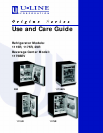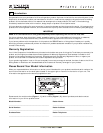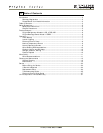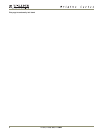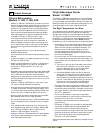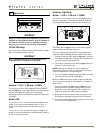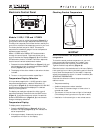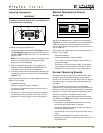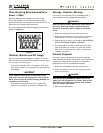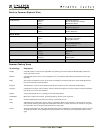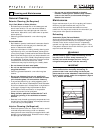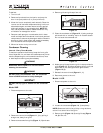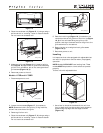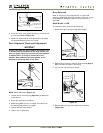
1115R, 1175R, 29R, 1175BEV 9
Adjusting Temperature
IMPORTANTIMPORTANT
Adjust the set point temperature in single
increments, and wait 24 hours for the temperature
to stabilize before rechecking.
Figure 7
To adjust the set point temperature:
1. Press and release either the WARMER (Figure 7, 4) or
COOLER (Figure 7, 5) button to put the controller in
the SET TEMPERATURE mode. The °F (or °C) symbol will
begin to flash.
NOTE: If no further action is taken, this mode will self
cancel in five seconds, and the original set-point
temperature will be displayed.
2. Within five seconds (while the °F (or °C) symbol is
flashing), press the WARMER or COOLER button as
required to adjust the set point temperature.
3. The change will be set five seconds after adjusting the
temperature, and the new set-point will be displayed
(Figure 7, 3)
.
Many factors can affect the internal temperatures of the
cabinet. They include:
• Temperature setting.
• Ambient temperature where installed.
• The number of times and length of time the door is
opened and closed.
• The amount of time the internal light is illuminated.
(This affects primarily product on top rack or shelf.)
• Installation in direct sunlight or near a heat source.
Manual Temperature Control
Model 29R
Figure 8
Adjust the temperature by turning the numbered dial
(Figure 8, 1) in small increments. Turn knob clockwise to
make unit colder and counterclockwise to make unit
warmer. After adjusting temperature, allow 24 hours for
unit to stabilize.
Many factors can affect the internal temperatures of the
cabinet. They include:
• Temperature setting.
• Ambient temperature where installed.
• The number of times and length of time the door is
opened and closed.
• The amount of time the internal light is illuminated.
(This affects primarily product on top rack or shelf.)
• Installation in direct sunlight or near a heat source.
Normal Operating Sounds
All models incorporate rigid foam insulated cabinets to
provide high thermal efficiency and maximum sound
reduction for its internal working components. In spite of
this technology, your model may make sounds that are
unfamiliar.
Normal operating sounds may be more noticeable
because of the unit’s environment. Hard surfaces such as
cabinets, wood/vinyl/tiled floors and paneled walls have a
tendency to reflect normal appliance operating noises.
Common refrigeration components, and a brief
description of the normal operating sounds they make,
are listed below. NOTE: Your product may not contain all
of the components listed.
• Compressor: The compressor makes a hum or pulsing
sound that may be heard when it operates.
• Evaporator: Refrigerant flowing through an evaporator
may sound like boiling liquid.
• Condenser Fan: Air moving through a condenser may be
heard.
• Automatic Defrost/Drain Pan: Water may be heard
dripping or running into the drain pan when the unit is in
the defrost cycle.
54321
ULIN_0074_A
1
ULIN_0014_A
ULIN_016357_30087.fm Page 9 Tuesday, March 14, 2006 2:36 PM



